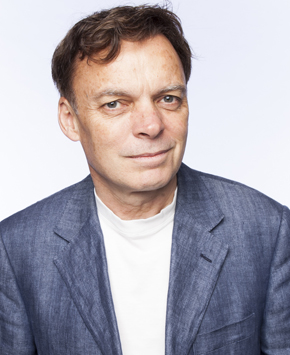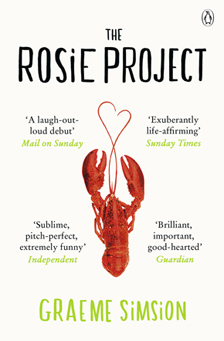The author project
by Graeme SimsionGraeme Simsion’s debut novel The Rosie Project tells the story of Don Tillman, a genetics professor with undiagnosed Asperger’s, and his awkward attempts to find love via a highly personalised psychometric questionnaire. Mark Reynolds fires off some questions about his mid-life reinvention as an internationally bestselling novelist, a transition that began when he sold his data analysis business to enrol in a screenwriting course…
MR: You first wrote The Rosie Project as a screenplay. At what point did you decide you wanted to turn that script into a novel, and what obstacles did you overcome along the way?
GS: At the beginning of 2012, I had developed The Rosie Project script to the point where it had won an award and I had a producer on board, but no funding. There were three main reasons for turning the script into a novel: first because it might help build interest in the film; second because I wanted to tell the story – and this was an alternative route to getting the story out there; third because I thought the novel form would allow the story to be told in a different way – perhaps more effectively. Most of the real obstacles were in story and character development, which I tackled when the story was in screenplay form. Writing the novel was (relatively) easy.
It took you five years to write the screenplay but just seven weeks to write the book. Was it a matter of transposing large chunks of dialogue and adding descriptive passages in between, or was it a complete rewrite?
I did take some dialogue directly from the screenplay, but the biggest contribution was having a very clear idea of story and characters. I knew exactly the story I was telling and who was in it. But the ‘passages in between’ are far more about Don Tillman’s observations and reflections – his inner world – than about description per se. These are a huge part – I would say the central part – of the book.
How much of the screenplay remains in the novel?
It’s essentially the same story and characters, but told differently – except, as noted earlier, for some dialogue which has been retained. In a novel, you can stretch dialogue – and indeed scenes – out more. The crucial difference is that the novel is in first person – Don Tillman’s point of view – but there are other storytelling differences, in particular the comedy in the novel is heavily based on observation (Don is effectively an observational comic) whereas in the screenplay it is more dialogue and performance-driven.
How have you drawn on your data-modelling skills to inform your approach to writing?
Data modelling is a design discipline akin to (say) architecture or software design. I would argue that the development of story (at least) is also a design discipline, and I’ve consciously drawn on design and creativity principles that I learned in my former job. I did a TedX talk for Melbourne University on this. One of the key ideas is that creativity can be managed – you can do more than just sit around hoping for magic to happen. And I’m a planner – I outline story first rather than just sitting down to write.
What other helpful skills and disciplines have you picked up from creative writing courses?
For me, creative writing courses have provided discipline, theory, review and encouragement to venture outside my comfort zone. I’ve written things for exercises and assignments that I’d never have written without that prompting, and my writing’s the better for it. I do some teaching now, which is wonderful for encouraging reflection and giving you the ability to do at will all the time what you otherwise do instinctively some of the time.
Which came first, plot or character? At what point did Don Tillman take centre stage, and when did Rosie emerge as his chief antagonist?
Character came first – Don Tillman’s character has always been centre stage through substantial story changes, including the replacement of the original female protagonist (a physicist named Klara) by Rosie. That happened after two and a half years’ work on the screenplay. The invention of Rosie was the single most difficult task in the evolution of the screenplay and novel. I wanted a character who would be everything Don didn’t want – or didn’t think he wanted, but who fulfilled unrecognised needs. And she had to be a credible motivated character in her own right; not a ‘manic pixie dream girl’ without her own agenda and needs.
How does a typical day pan out since you became a full-time writer?
No such thing. I don’t have a routine. To some extent this comes from my past practice of fitting writing around the very variable load of my day job (self-employed teaching and consulting) but it’s also a function of fitting in public speaking commitments and all the ‘non-writing’ stuff that goes with being a full-time writer.
What was the impact of winning the Victorian Premier’s Prize for an unpublished manuscript?
The major impact came from being shortlisted. It brought the book to the attention of publishers and led to a contract with Text Publishing. Everything else flowed from there.
How quickly did Australian and international publishing deals follow after you won the prize?
I won the prize in early June 2012 and signed the deal with Text in Australia later that month. Most of the international deals followed two to three months later. The smaller ones are still coming in (we’re up to 40 territories and 37 languages) and we’ve now done deals for my next two books with several publishers.
The Rosie Project has been optioned by Sony. Are you reworking the original screenplay yourself, or is the next stage of development in the hands of others? And what is the current state of play?
Sony has retained me as screenwriter, and I’ve just submitted the first formal draft to the studio. My starting point was the original screenplay. But early days yet!
Your website mentions two current novel-writing projects: Walk to the Stars, ‘a novel set on the Camino de Santiago’, and The Candle, about ‘rekindling a relationship after twenty years’. Is the latter a direct sequel to The Rosie Project? What stage have you reached with each manuscript, and when can we expect the next book to be out?
I have written first drafts of both (Walk to the Stars in collaboration with my wife who is also a writer). Neither is a sequel to The Rosie Project: but a sequel is what I’m working on now, with a publication date tentatively set for late 2014 in Australia.
To what extent will Walk to the Stars draw upon your own walk along the Santiago trail? How did that walk come about, and in what ways was it ‘life-changing’?
A lot! At least the protagonists will follow the same route (from Cluny in France via the Pyrenees and North Coast of Spain) that my wife and I took. The walk was perhaps more obviously life-changing for my wife, who cut back her demanding job as a professor of psychiatry to spend time on her writing, but it taught both of us something about living in the moment, being aware of our physical surroundings, and not needing too many possessions.
What is your number one tip for aspiring writers?
Get help. Writing is often portrayed as a solo, isolated activity, but I think classes, writers’ groups, mentors, writing partners have a crucial role to play for most of us in providing feedback and encouragement. One of the things I learned from screenwriting is the value of collaboration in story development (if not in the actual writing).
 Graeme Simsion is a full-time writer of screenplays, short stories, novels and short plays. Previously an IT consultant and educator, he wrote his first book, on data modelling, in 1994, and taught at four Australian universities. He is married to Anne, a professor of psychiatry who writes erotic fiction. They have two children. The Rosie Project is published in the UK by Penguin in paperback and eBook. Read more.
Graeme Simsion is a full-time writer of screenplays, short stories, novels and short plays. Previously an IT consultant and educator, he wrote his first book, on data modelling, in 1994, and taught at four Australian universities. He is married to Anne, a professor of psychiatry who writes erotic fiction. They have two children. The Rosie Project is published in the UK by Penguin in paperback and eBook. Read more.
therosieproject.co.uk
Mark Reynolds is a freelance editor and writer, and founding editor of Bookanista.



